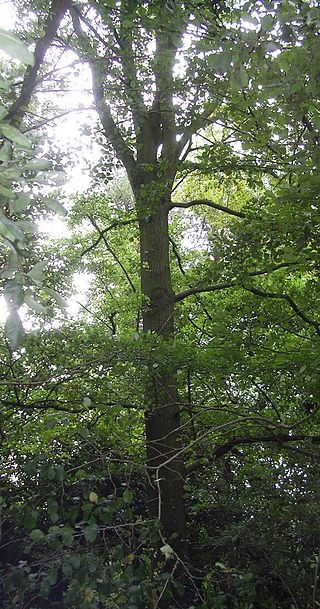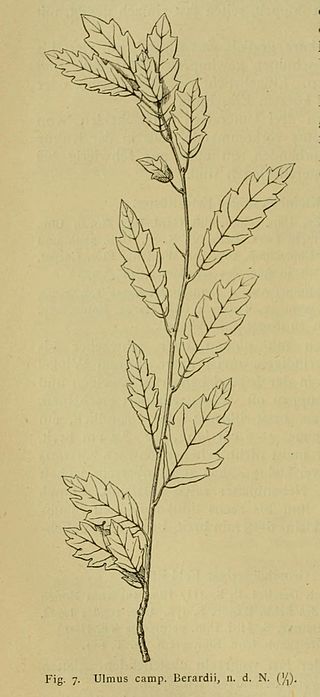Related Research Articles

Ulmus rubra, the slippery elm, is a species of elm native to eastern North America. Other common names include red elm, gray elm, soft elm, moose elm, and Indian elm.

Ulmus pumila, the Siberian elm, is a tree native to Asia. It is also known as the Asiatic elm and dwarf elm, but sometimes miscalled the 'Chinese elm'. U. pumila has been widely cultivated throughout Asia, North America, Argentina, and southern Europe, becoming naturalized in many places, notably across much of the United States.

Ulmus 'Urban' is an American hybrid elm cultivar selected from the progeny of a controlled crossing of the Siberian Elm Ulmus pumila with the Dutch clone '148' in 1958 by Toru Arisumi of the USDA at Columbus, Ohio. Clone '148' had been sent to the US from the Netherlands in 1952 by Johanna Went, leader of the elm research team at the Willie Commelin Scholten Phytopathology Laboratory in Baarn.
The Siberian elm cultivar Ulmus pumila 'Green King' was once believed to have been derived from a crossing of the Siberian Elm Ulmus pumila with the American Red Elm Ulmus rubra. However, it is now apparent the tree originated as a sport of U. pumila in 1939 at the Neosho Nurseries, Neosho, Missouri.

The Field Elm cultivar Ulmus minor 'Christine Buisman' was the first cultivar released by the Dutch elm breeding programme, initiated in response to the less virulent form of Dutch elm disease (DED), Ophiostoma ulmi, which afflicted Europe's elms after the First World War. 'Christine Buisman' was selected from a batch of 390 seedlings grown from seed collected in the Parque de la Quinta de la Fuente del Berro, Madrid, by Mrs Van Eeghen, a friend of elm researcher Johanna Westerdijk, in 1929 and named for the elm disease researcher Christine Buisman. Originally identified as Ulmus foliacea, it was later treated as Ulmus × hollandica by Melville. However, more recent research in Belgium using DNA markers has reaffirmed 'Christine Buisman' as a clone of U. minor.

The Siberian elm cultivar Ulmus pumila 'Dropmore' was grown from seed collected in Harbin, Manchuria, China, by F. L. Skinner, of Dropmore, Manitoba. Green reported (1964) a suggestion to merge the Siberian elm cultivars 'Harbin' and 'Manchu' with 'Dropmore', as all came from the Harbin area. In the event, 'Dropmore' appears to have superseded these earlier cultivars.

The Siberian elm cultivar Ulmus pumila 'Hansen' is a little-known American tree, raised from seed collected by the horticulturist and botanist Prof. Niels Hansen during his expedition to eastern Siberia in 1897, and further developed in South Dakota.
The Siberian Elm cultivar Ulmus pumila 'Harbin' is an older Manchurian selection, grown from seed collected from an area with a similar climate to that of the Great Plains, and superseded in the United States by 'Dropmore'. Green reported (1964) a suggestion to merge 'Harbin' and the Siberian elm cultivar 'Manchu' with 'Dropmore', as all came from the Harbin area.
The Siberian Elm cultivar Ulmus pumila 'Manchu' was raised by Stewarts Nurseries, Sutherland, Saskatchewan, c. 1951 from seed collected by Mr Ptitsin from near Harbin, China, an area which has a similar climate to that of the Great Plains. Green reported (1964) a suggestion to merge 'Manchu' and the Siberian elm cultivar 'Harbin' with 'Dropmore', as all came from the same area.

Ulmus 'Patriot' is a hybrid cultivar raised by the United States National Arboretum in 1980. Derived from a crossing of the American hybrid 'Urban' with the Wilson's Elm cultivar 'Prospector', 'Patriot' was released to commerce, free of patent restrictions, in 1993. Tested in the US National Elm Trial coordinated by Colorado State University, 'Patriot' averaged a survival rate of 85% after 10 years.

The elm cultivar Ulmus 'Berardii', Berard's Elm, was raised in 1865, as Ulmus Berardi, from seeds collected from large specimens of "common elm" growing on the ramparts at Metz, by an employee of the Simon-Louis nursery named Bérard. Carrière (1887), the Späth nursery of Berlin and the Van Houtte nursery of Gentbrugge regarded it as form of a Field Elm, listing it as U. campestris Berardii, the name used by Henry. Cheal's nursery of Crawley distributed it as Ulmus nitens [:Ulmus minor] 'Berardii'. Smith's of Worcester preferred the original, non-specific name, Ulmus 'Berardii'.

The Siberian Elm cultivar Ulmus pumila 'Pendula' is from northern China, where it is known as Lung chao yü shu. It was classified by Frank Meyer in Fengtai in 1908, and introduced to the United States by him from the Peking Botanical Garden as Weeping Chinese Elm. The USDA plant inventory record (1916) noted that it was a "rare variety even in China". It was confirmed as an U. pumila cultivar by Krüssmann (1962).
The hybrid elm cultivar Ulmus 'Hamburg' was originally raised by the Plumfield Nurseries, Fremont, Nebraska, circa 1932, after its discovery by Mr. Lloyd Moffet in a bed of Siberian Elm Ulmus pumila seedlings from Tekamah. It was later marketed by Interstate Nurseries, Hamburg, Iowa, from 1948, as 'Interstate's New Hamburg Hybrid Elm'. Green stated that it was originally said be a hybrid of Ulmus pumila and Ulmus americana, but the Hamburg Nurseries of Iowa made no such claim for it in their catalogues from 1948 onwards. It is now considered more likely that Ulmus rubra was the male parent, as it was also known as 'Hybrid Chinese Elm', and therefore probably synonymous with Plumfield Nurseries' 'Hybrid elm' of the same date, a known crossing of U. pumila and U. rubra, – and so, perhaps, also synonymous with Ulmus × intermedia 'Fremont', an elm of the same parentage found a little later in Plumfield Nurseries.
The American Elm cultivar Ulmus americana 'Sheyenne' was raised by the Northwest Nursery Company of Valley City, North Dakota, before 1941, from a local elm in nearby Chautauqua Park.

The Siberian elm cultivar Ulmus pumila 'Pinnato-ramosa' was raised by Georg Dieck, as Ulmus pinnato-ramosa, at the National Arboretum, Zöschen, Germany, from seed collected for him circa 1890 in the Ili valley, Turkestan by the lawyer and amateur naturalist Vladislav E. Niedzwiecki while in exile there. Litvinov (1908) treated it as a variety of Siberian elm, U. pumilavar.arborea but this taxon was ultimately rejected by Green, who sank the tree as a cultivar: "in modern terms, it does not warrant recognition at this rank but is a variant of U. pumila maintained and known only in cultivation, and therefore best treated as a cultivar". Herbarium specimens confirm that trees in cultivation in the 20th century as U. pumilaL. var. arboreaLitv. were no different from 'Pinnato-ramosa'.

Ulmus parvifolia, commonly known as the Chinese elm or lacebark elm, is a species native to eastern Asia, including China, India, Japan, Korea, and Vietnam. It has been described as "one of the most splendid elms, having the poise of a graceful Nothofagus".

Ulmus pumila, or 'Poort Bulten,' is a Siberian elm cultivar propagated from a tree in Arboretum Poort Bulten in Losser, Netherlands. The original, planted c.1912 by landscape architect Leonard Springer, was included in what was mainly a collection of evergreens, most of which were felled for firewood during World War II. Following a post-war inventory error, for many years the tree was mistaken for Planera aquatica or 'water elm' and commercially propagated under that name. Later research determined it an U. pumila form from Mongolia.

The hybrid elm cultivar Ulmus × intermedia 'Fremont' is a little-known American hybrid cultivar propagated from a tree found on the Lloyd Moffet property at Fremont, Nebraska. The hybrid is believed to have arisen from a crossing of Ulmus pumila and one of the spring-flowering elms native to North America, probably Ulmus rubra. The source tree was probably an unsold specimen of the Plumfield Nurseries' "Hybrid Elm", a cross between "Chinese elm" and Red elm U. rubra, briefly marketed from 1942 to 1943, but not appearing in later catalogues. This hybrid may have been the same as the cultivar sourced from Plumfield Nurseries at this time as "Hybrid Chinese Elm" and later marketed by the Interstate Nurseries, Hamburg, Iowa, as 'Hamburg'.
The American Elm cultivar Ulmus americana 'Great Plains' was a clone raised by nurseryman Wedge of the Oscar H. Will & Co. Nurseries, Bismarck, North Dakota, in the 1930s and first listed in the company's 1942 catalogue as 'Great Plains American Elm'.
References
- ↑ Ulmus pumila 'Chinkota'; hort.uconn.edu
- ↑ Arnoldia : Bulletin of the Arnold Arboretum, 24 July 1964, Vol 24 Nos 6-8, pp.40-80
- ↑ Santamour, Frank S.; Bentz, Susan E. (May 1995). 'Updated Checklist of Elm (Ulmus) Cultivars for use in North America', Journal of Arboriculture. 21 (3); pp.122–131.
- ↑ Collins, P. E. (1955). Chinkota Elm. South Dakota Farm and Home Research. 7 (1), 14–16, 27. South Dakota State University, Brookings, USA
- ↑ Siberian elm, northern.edu
- 1 2 Dodge, A. F. (1960). Woody ornamental and shelter plants for the North Central Region 1954–1959: Five year report on regional plantings of Chinkota Elm (Ulmus pumila L.). USDA - ARS, Iowa State University, Ames, Iowa, USA